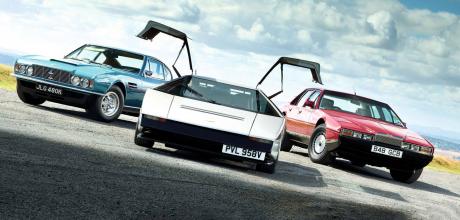Aston Martin DBS, Lagonda and Bulldog - plus the inside story of the man with the radical plan
The man, the myth, the Lagonda…… .and so much more. Peter Tomalin celebrates the life and works of a remarkable design talent — with special guest stars from Aston Martin, including DBS V8 and Bulldog.
Photography Matthew Howell/Amy Shore/Towns family archive
How William Towns gave the British marque its cutting edge
Aston Martin DBS, Lagonda and Bulldog — plus the inside story of the man with the radical plan
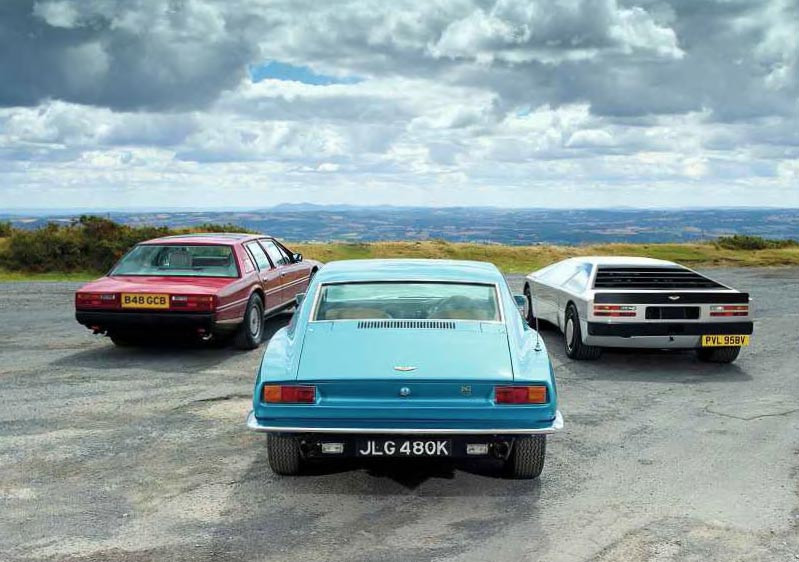
‘THE RESULT WAS A MODERN LOOKING GT, AND ASTON MARTIN HAD A NEW SIGNATURE SHAPE’
Were on a Shropshire hillside, late summer, awaiting three significant cars. Our muster-point is populated by dog walkers, ramblers and the odd commercial traveller enjoying the views over a coffee cup. Suddenly, heads swivel as the lightly muffled roar of a big V8 announces the arrival of an early-70s Aston Martin DBS; seconds later, one or two of the ramblers pause mid-step and stare as the impossibly long, chiselled form of a Lagonda saloon follows it in. And now everyone’s attention is laser-locked as the Earth-skimming spaceship that is the Aston Martin Bulldog appears amid a crackling cacophony of sound. The youngest of these cars is more than 40 years old, yet their power to shock and entrance is undiminished. Ladies and gentlemen, welcome to the world of William Towns.
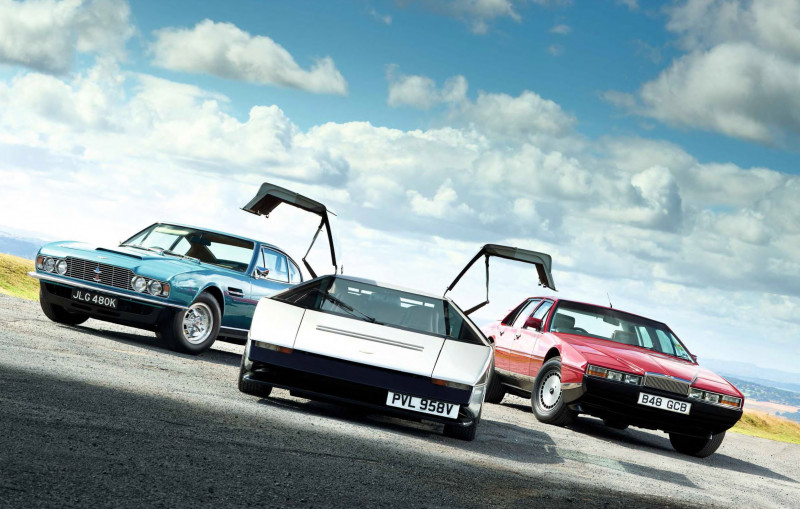
Bill Towns, as he was often known, is probably best remembered for the Lagonda ‘wedge’, the outlandish four-door saloon that wowed the crowds at the 1976 British Motor Show. His name has also been back in the media with the re-emergence of the spectacular Bulldog supercar, another of his designs, fresh from a painstaking restoration. But there was so much more to Towns. Away from the automotive arena, his work embraced everything from lawnmowers via furniture to water sculptures. Within it, as well as Aston Martin Lagonda, he worked for Rover, the Rootes Group, Reliant and Jensen among others, and became a maker of kit cars with the innovative Hustler.
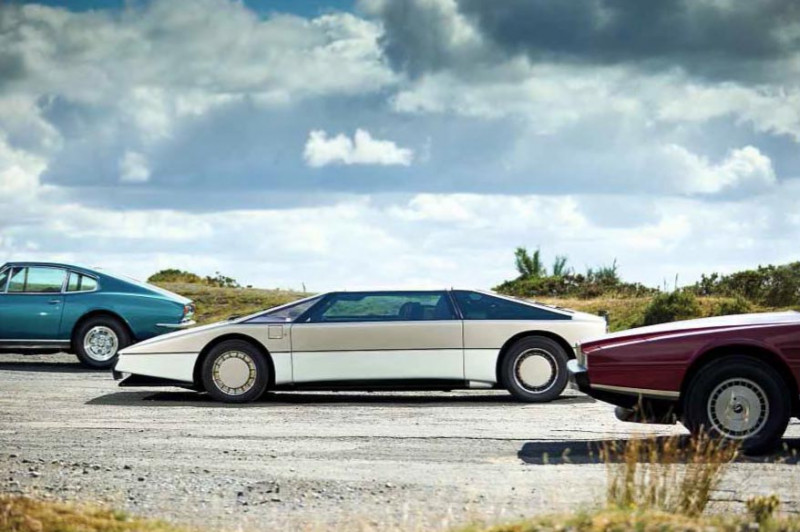
‘HIS NEXT LANDMARK COULDN’T HAVE BEEN MORE DIFFERENT FROM
THE SUAVE DBS’
The car that brought him to prominence, though, was the Aston DBS, and the story of its conception says a lot about the man. It was 1966 and Aston had a long-standing partnership with the Italian design house, Touring of Milan, while the recently arrived Towns, barely 30, was a lowly seat designer at Newport Bagnell. But such was his self-belief that, when the bosses rejected Tourings proposal for the new model, Towns presented his own sketches in the form of a hand-bound brochure. David Brown and his senior managers liked what they saw, and Towns was given the job of designing what would become the DBS. The result was a thoroughly modern-looking GT car, and Aston Martin had a new signature shape that would endure for more than 20 years.
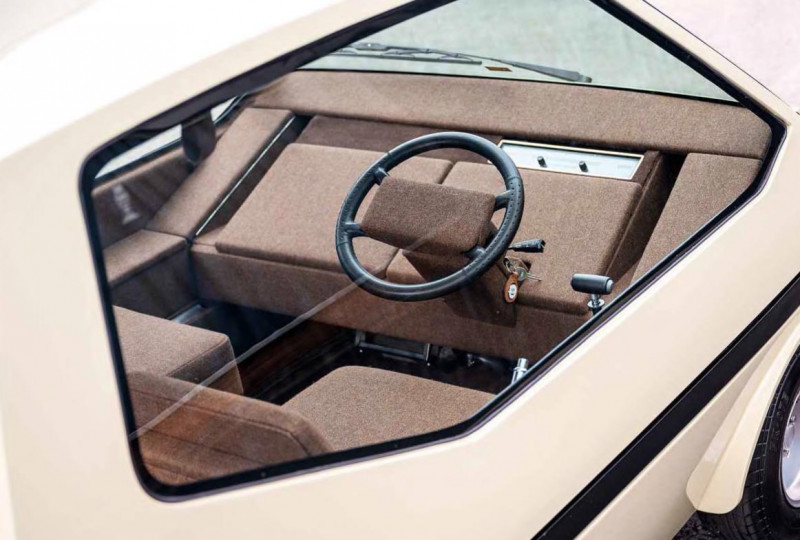
AS THE BULLDOG IS LET OFF THE LEASH, AN EXPLETIVE LEAVES MY LIPS AS MY HEAD IS JERKED BACK’
When the DBS V8 arrived in 1970 the new Aston finally got the 160mph performance to match its road presence, eloquently illustrated here by serial Aston collector Tom Westleys immaculate 1971 example. ‘I remember seeing the DBS at the motor show and thinking “Wow”,’ says Tom. And when the V8 came out, it was the fastest four-seat production car in the world.’
It’s an undeniably handsome, beautifully proportioned machine, well able to stand comparison with the best Continental GTs of the day — the Maserati Ghiblis, Iso Grifos and Monteverdis. Towns had originally wanted a lower, smoother nose, but management decreed that it should retain a more traditional Aston grille. The way Towns blended the two was masterful. A major design talent had emerged.
Next June it will be 30 years since Towns died, from cancer, aged just 56.1 meet his widow, Lizzie Cariss, at the Warwickshire home they shared for the last ten years of his life. She’s smart, vivacious, good fun.
‘We met at a pub, in Kenilworth, 19641 think it was,’ she tells me over lunch. ‘I was 19 and living in London, working for the Duchess of Bedford; he was 28 and working at Rover — I remember he had a Rover 2000 at the time, and an MGB.’ Towns was always car-mad, later indulging his passion with an E-type Jaguar, a Jensen Interceptor and a string of Bentleys and Rolls-Royces. His father was a director of Hilger & Watts, which produced scientific instruments. ‘William’s inventiveness clearly came from his dad,’ says Lizzie. Recently rediscovered film clips reveal him to have been extremely well-spoken: ‘I’d forgotten he was quite so plummy!’ she laughs. Sent to hoarding school when he was eight, then to a ‘pretty grim’ public school, William went straight from there to an apprenticeship with Rootes in Coventry in 1954, aged 18. ‘He knew he wanted to be a designer, but there was no obvious place to go. Now you’d go to art college and there’d be a course for you, but in those days there was nothing like that.’
The drawing office suited someone who had always sketched cars for fun. Though mostly engaged on seats and doorhandles, towards the end of his time there he worked on the crisply styled Hillman Hunter. The move to Rover in 1963 was Towns’ first major break. He worked under David Bache on details of the Rover 2000, the slim alloy grille and twin headlamps with inset bezels of which were echoed in the DBS. But his first opportunity to design a complete car came from an unlikely source.
Despite its rather staid image, Rover was heavily invested in gas turbine-powered cars, and in 1963 teamed up with BRM to field a race car at Le Mans. Its original form was rather bulbous, with an open cockpit, but it performed well enough for the team to return the following year — with a completely new, closed coupe version. The job of designing it fell to the young Towns. The sleek, crisply drawn new prototype (with a commendably low drag coefficient of 0.32) didn’t run in the ’64 event, but returned in 1965 with Graham Hill and a promising youngster by the name of Jackie Stewart sharing the driving, finishing 12th overall and second in the 2-litre class.
The following year was to be a momentous one: William and Lizzie were married and William started his new job at Aston Martin. But even after getting the DBS gig, there was nothing glamorous about the designer’s life at Newport Bagnell. ‘It was ridiculous,’ says Lizzie; ‘he only had this small area so he got some wardrobes and made a wall to create a space for himself, a little studio.’
It wasn’t enough. Towns left Aston Martin before the end of 1968, though he continued to work for the company as a freelance. ‘A friend he’d met at Rover started a design studio and persuaded William to join him,’ says Lizzie, who found a role there, too. ‘But this chap was full of grandiose ideas and on 1 January 1969 the business folded. We’d bought this crumbling old pile near Moreton-in-Marsh and suddenly we were both out of work with a baby on the way. [Range Rover creator] Spen King was lovely and offered William a job, but William said “Well, we’ve seen how not to do it, maybe we’ll have a go on our own.’”
And from that point on, Towns was his own man with his own company, Interstyl. ‘We had this beautiful barn that became his studio,’ says Lizzie. ‘He picked up a contract from the failed partnership and then another job came along and we just ticked along like that. We bought this lunatic GMC motorhome and the person we bought it from was connected with Westwood Mowers, and from that we got masses of lawnmower design work.’
There was a steady drip of automotive work, too, including a facelift for the early ’70s Jensen-Healey, later a redesign for the Reliant Scimitar SSI (renamed SST for Towns) and freelance work for Aston Martin. His next landmark, though, couldn’t have been more different from the suave DBS. Minissima was a Mini-based concept for a future city car (originally called Townscar — a neat pun) and was radical not only for its tiny footprint but also for the fact that it had a single, side-hinged rear door, the thinking being that it could be reversed up to the pavement so that the occupants could step out safely.
British Leyland bought the commercial rights and displayed the car on its 1973 Motor Show stand as the Mini of the future. ‘They paid £20,000 for it,’ says Lizzie. That’s the equivalent of £280,000, today, no less. ‘The deal was that if they didn’t produce anything within two years, we’d get it back.’ Which, after two years on the show circuit, was exactly what happened. The concept was later sold on and reworked as a Design Council Award-winning carriage for wheelchair users.
Meanwhile, Towns had been working up new designs for Aston Martin, which in 1975 found itself under new ownership. This time it was a four-door that caught the imagination of the bosses. As then- chairman Peter Sprague later recalled: ‘The four company directors all felt we wanted to own the car in William’s drawings — and we wouldn’t ever be able to drive it if we didn’t build it.’ Just nine months later, the new Lagonda appeared on the Motor Show stand.
Mike Loasby was chief engineer on the Lagonda, having first met Towns almost a decade earlier. ‘William I knew from the beginning,’ he told me when we met at his Shropshire home. ‘He was at Aston when I joined in ’67 as a development engineer. We drifted together, as it were, during the early build stages of the prototype DBS.’ Loasby contends that, while the Lagonda was the high point of Towns’ Aston years, ‘equally remarkable an achievement was the lasting success of the DBS/ AMV8, which ran for so many years and had such presence’.
He added: ‘William was a master of detail, not just being sure of what was required but making sure that it was done, determinedly pressing on to finish the whole design to the nth degree. He considered that all of the vehicle — outside and inside — should be treated as a single entity.’
We now know that the instruments and touch-sensitive switchgear suffered from a lack of development, but there was no question they suited the avant-garde nature of the Lagonda. As Loasby observed: ‘We built on each others’ ideas, particularly when it came to the Lagonda. The electronic instrumentation was completely new and very exciting. For Aston Martin it was a great leap into the present!’
Towns was notoriously reluctant to compromise. So did the packaging constraints of such an extreme shape create problems for the engineers? ‘Yes,’ said Loasby. ‘We had to lower the engine, which meant redesigning the airbox, the inlet manifolds and the sump.’
Performance suffered slightly as a result. But nothing could detract from the impact that Towns’ radical, razor-edged saloon had on the automotive world. ‘The 1976 Motor Show was incredible,’ said Loasby, recalling how deposits flooded in. ‘Rolls-Royce got terribly peeved, because they had the next stand, and people were standing on their railing to look at our car.’
The Lagonda you see here has been brought along by David Marks, and few know the model better. His company, Nottingham-based David Marks Garages, has become something of a ‘wedge’ specialist, and his brother Robert has spent years finding solutions to their various electronic foibles. This car is one of three the brothers own, and it was the first production version to feature cathode ray tubes for the main instrumentation: imagine three miniature old-school TV screens embedded in the dash. As with everything else about the Lagonda, it’s simultaneously bonkers and utterly beguiling.
‘The CRTs came from an F15 fighter jet and are very tough — it’s the electrics behind them that gave the problems,’ says David. ‘The Lagonda was very forward-thinking, but trying to make three CRTs work on a 12-volt DC system in a car that’s bouncing around… very tricky.
‘We’ve got them to work and this car has been all over Europe. I’ve seen 120mph and have often cruised at 100mph, and it feels very stable at that sort of speed. And with the instruments and switchgear illuminated, driving at night is a glorious experience.’
And the coolest bit of all? When you turn on the ignition and the CRTs have come to life, the car announces ‘All systems go!’ in a voice that’s so plummy it could be Towns himself.
Deposits for the Lagonda kept the factory lights on in the late ’70s, and the subsequent success of a newly refreshed AMV8 — known as the Oscar India model, another Towns design — saw Aston Martin reinvigorated. When the Lagonda was finally withdrawn from the catalogues in 1990, some 645 had been sold — no small number in Aston terms.
And then there was Bulldog. In late 1976, in the ‘lull after the storm’ of the wedge Lagonda, Loasby and Towns began to discuss a new project. ‘We thought an ultimate sports car would be an exciting thing to do — and fun,’ Loasby would later recall. ‘So we talked about a concept that would be mid-engined, very low and very fast.’ Aston Martin had never built a mid-engined car before, but there was no faulting the scale of the ambition: a target of 750bhp-plus from a twin-turbo version of the V8 engine and a projected top speed of 230mph. ‘All we had to do,’ said Loasby, ‘was have as small a frontal area as possible combined with a minimal Cd.’
Towns’ solution was the lowest, leanest sliver of glass and metal imaginable, with gullwing doors that cut deep into the sills, and an aesthetic that took the angular forms of the Lagonda to their ultimate expression — Loasby want completely sold. I can’t say [Bulldog] was a very pretty car. William’s styling was getting a bit extreme at that stage...’
Not pretty, perhaps, but arresting like few others. When the one-off Bulldog re-emerged into the public gaze last year after a two-year restoration by Bridgnorth-based Classic Motor Cars, the waves it made at top concours events were reminiscent of the Lagonda’s show-stopping debut 45 years earlier. And now the plan is to see it crack the 200mph barrier that it narrowly failed to breach in period.
The moving force behind all of this is American entrepreneur and collector Phillip Sarofim, something of a Towns evangelist ever since he acquired a six-wheel version of his Hustler kit car. Speaking from his home in Los Angeles, Phillip tells me: I loved the design of the Hustler and began researching a bit about William Towns. He believed in the democratisation of design and was solving problems while trying to make things aesthetically interesting. He is one of the most fascinating designers of the 20th Century, an unsung hero.’
Phillip heard about Bulldog through Richard Gauntlett, son of the late Aston Martin chairman Victor: ‘It wasn’t for sale. After years of negotiation I became its fortunate custodian’ he says. The CMC restoration returned the car to its original form, exactly as Towns had envisioned it. ‘We will show the world what it was capable of when we do our 200mph run’ adds Phillip.
Until the final dynamic details have been polished, only the owner and those intimately involved in the project have actually got behind the wheel, but I can’t resist the opportunity to experience William Towns’ hypercar — a car that I’ve been reading about for more than 40 years — as a passenger. You sit semi-recumbent in the hip-hugging buckets, and there’s a high-pitched whirring as hydraulic rams close the palpably heavy doors, which seem to wrap around almost beneath you.
Move away and the dominant element is the soundtrack: a collection of noises, the composition and intensity of which I’ve never experienced in a road car, but then no other car of this vintage puts a socking great V8 engine and two large and very vocal turbochargers just inches behind your head. Those turbos sound almost like two jet turbines spinning and whistling away, like an airliner preparing for take-off.
As we pick up speed the ride’s firm but not too jarring: the suspension is still set up as it was for Bulldog’s demo runs at the Goodwood Festival of Speed, so there’s more compliance to be had — although, with no rubber in the suspension joints, it’s never going to deliver GT levels of refinement. But when the road opens out and the Bulldog is let off the leash, an expletive leaves my lips as my head is jerked back. It feels brutally quick, and the acceleration just keeps coming. Each gearchange brings a brief interruption, then the surge starts again, all the while the turbos keening with an almost drill-like intensity — the ghosts of the Rover-BRM are riding with you. It’s raw, visceral, sensory overload.
Another massive towns fan is Aston Martin’s current studio head and chief creative officer, Marek Reichman. ‘Bill Towns was very important in the language of futuristic design/ he tells me. ‘When we were transitioning out of the sculptural body forms of the ’50s and ’60s there was a move to advocate change and we saw forms that were a lot more dramatic. Gandini’s shift from Miura to Countach was probably the most extreme shift from the emotional, very fluid surface to this wedge with one single line through it. Bill created that language in this country.’
Reichman paid homage to the Towns wedge with his own Lagonda Taraf and a number of Lagonda concepts in the spirit of Towns. ‘Bill Towns’ Lagonda was significant because of the extreme nature of just what can you do with a four-door sedan; this car proportionally is so dramatic, low to the ground, bonnet height versus windscreen angle and rake… It’s literally what Musk did with his Cybertruck — that’s how much that car has influenced the planet. People react to Bulldog in a similar way. You’re seeing complete drama.’
Just how highly does Reichman rate Towns? ‘He’s got to be praised as one of the all-time greats. He is our Giugiaro, our Michelotti. I’m sure, had he not had such an English name, he’d be more celebrated.’
No matter how unassuming his name, life with William Towns was never dull, says Lizzie Cariss. ‘He’d often get up in the morning and say “I’ve just had an idea...’” One such idea was Microdot, the 1976 petrol-electric hybrid city car that was literally decades ahead of its time. When I ask Lizzie which of all William’s designs was he most proud, she replies without hesitation: ‘Microdot. Because it was breaking new ground, and because the styling he thought was the most successful.’ And then in 1978 came the Mini-based Hustler kit car. ‘That was another “Ooh, I’ve just had this idea” moment,’ says Lizzie. ‘Eleven weeks later we had something on the road! They were exciting times, and we were getting orders every day. It was nice steady income for quite a long time.’
Around 500 Hustlers were produced — four- and six-wheelers, some specially adapted for disabled drivers, others used as delivery vehicles, budget versions built from marine ply. In response to complaints about the rather insipid performance, Towns even developed a version with a Jaguar 5.3-litre V12 engine.
‘We didn’t have many holidays, but life was always exciting,’ says Lizzie. And then in 1991, at just 55, Towns was diagnosed with cancer. ‘One day he just said “I don’t feel very well.” He had his big operation and recovered but 18 months later it came back. He died here that June.’
Towns had been working on prototypes for a water bike. I think, with William, he had his life exactly as he wanted it. Right up until the end it was always “next project, next project”. He didn’t live as long as he should have done, but I take great comfort that there wasn’t one day when he wasn’t thrilled about what he was going to do next.
Clockwise, from left The Towns trio; Bulldog leads DBS on road; Reichman's Taraf reflects on its Lagonda inspiration; Towns' final project was a ‘water bike'.
Left and facing page; below and below left Bulldog was an audacious concept that caused a stir with the promise of its 750bhp twin-turbo V8; Hustler kit-car was rather more democratic; hybrid Microdot followed on from Towns' Minissima.
Clockwise, from top left Towns' sketch for a two-door Lagonda; Bulldog followed from Lagonda yet was more extreme; Towns with an early ‘wedge’; this 1980s example shows its CRT screens from the F15 fighter jet
Clockwise, from left Towns' widow, Lizzie, with a picture of the twc of them in happy times; Minissima's minimalist interior; Towns designed the Guyson E-type; radical entry for Minissima; the Towns family motorhome; re-clad Rover-BRM was far more elegant than the original.
Above, from left Scrapbook pictures include portrait of the artist at work; Lizzie Cariss looks fondly over her late husband's designs; the stylish DBS was his first work for Aston Martin — later cars were rather more radical.


